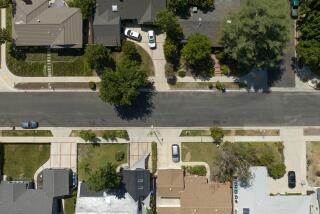Smart Sprinklers Sense Landscape Water Needs
First there was the low-flow toilet, then the water-thrifty shower head. Next: the smart sprinkler.
The gadget -- a box that attaches to a home sprinkler system and controls it according to weather data -- has yet to be mass-marketed.
But water officials are already touting it as the device that will help Southern Californians kick the habit of lavishing too much water on their lawns and gardens.
“These things will far out-shadow anything the toilet has done,” said Adan Ortega, a vice president of the Metropolitan Water District, which imports water from outside the region and sells it to 26 agencies in six Southern California counties.
The MWD and its member water agencies are still deciding how to publicize the device and what type of rebate to offer consumers who buy it. But Ortega said that, within perhaps two years, the unit could be common in many Southland homes, saving residents hundreds of dollars a year.
The smart sprinkler solves an old problem. To hear water agencies tell it, many Southern Californians over-water their lawns and gardens.
In Ortega’s words, “They’re loving them to death.”
The new gadget casts emotion aside. Using weather data sent by satellite from the manufacturer in Northern California, it determines the plants’ rate of “evapotranspiration,” or moisture loss, and the amount of water they need. Then it adjusts how much the sprinklers release.
On a hot summer day, the sprinklers would run more. On a cool and cloudy day in winter, they might not run at all.
“The beauty of it is that it takes human behavior out of it as much as possible,” said Dana Haasz, a water policy researcher at the Pacific Institute, a Bay Area think tank.
Tests of the smart sprinkler in several cities around the arid West, including Irvine Ranch and Santa Barbara, over the last several years found that it can save roughly 40 gallons of water a day per average home. In Southern California, that’s about a 25% savings.
The trials were so encouraging that MWD officials say smart sprinklers, if widely used, could shave 10% from the region’s annual water consumption, saving enough to serve 300,000 families.
“A lot of things have been done inside the homes, but we’ve never done anything for outside water efficiency. That’s the reason this is important,” said Tom Ash, the conservation specialist for the Irvine Ranch Water District.
The most advanced sprinkler controller is made by HydroPoint Data Systems of Petaluma. The company sells it for about $285, including installation and two years of satellite data.
The MWD and many local water districts are trying to decide whether to also sell the devices, and how much of the cost they would rebate to their customers. HydroPoint says the device could save many consumers $25 a month or more.
While studying the smart sprinkler, water officials stumbled onto another benefit. The less people water their yards, the less polluted runoff -- tainted by contaminants such as pesticides and dog feces -- flow from their yards and ultimately to area streams and then the ocean.
“It looks like, from our test area, approximately a 45% reduction in runoff,” Ash said. “I would have been thrilled with 25%.”
Water agencies have long known that more than half the water used by the average Southern California home goes to outdoor watering. And many homeowners never adjust their sprinkler systems.
Yet water officials, who in many districts are elected, have been loath to do anything about it. They don’t want to ask people to make sacrifices, they say, unless the situation is dire -- such as in an extended drought.
Finding new water supplies for California is an increasingly difficult task because most sources in the West have already been tapped. At least one of the region’s traditional sources -- the Colorado River -- has reached its political and environmental limits.
The MWD’s share of Colorado River water was cut nearly in half by the federal government on Jan. 1 to rein in California’s use of the drought-plagued river. That loss -- enough for more than 400,000 families for one year -- means the region will be more dependent for now on the Sierra snowpack, which has been below normal in recent years because of dry winters.
“We think one of the best sources of new water out there is the water we save through conservation,” Ortega said.
The MWD is looking to improve conservation with other new measures as well. It recently launched a $2.5-million advertising campaign to persuade Southern Californians to use more native plants in their yards, because the natives are suited to the arid climate and need less water.
And the agency recently targeted X-ray machines, which can use about a million gallons of water a year. The MWD is offering $2,000 rebates to hospitals and other medical businesses that buy water-efficient machines that use only 100,000 gallons a year.
More to Read
Sign up for Essential California
The most important California stories and recommendations in your inbox every morning.
You may occasionally receive promotional content from the Los Angeles Times.










